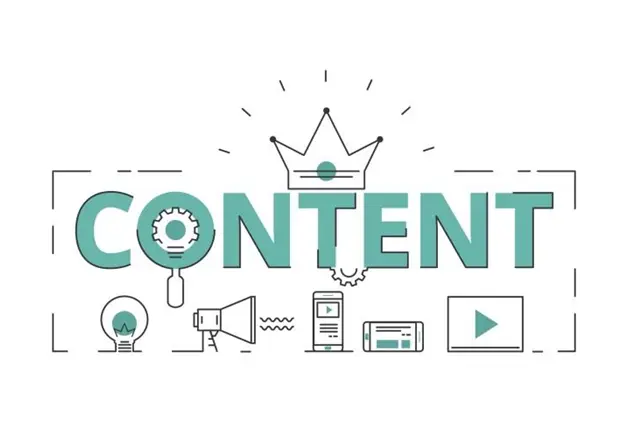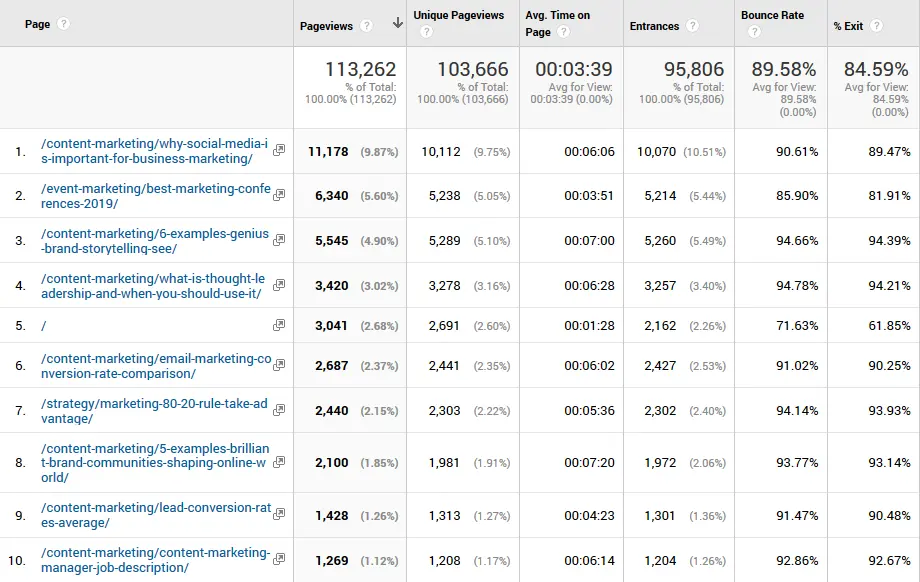
What is Content Marketing?
Content marketing is a strategic marketing art that aims to attract the audience and urge them to take action through interacting with valuable/useful information. So, Instead of paying money for advertising campaigns, people will start sharing your content materials such as articles, videos, infographics, and social media posts.
If they really like your content, the magic will happen, and your content will spread virally and better than the biggest campaign you ever imagine. People start sharing your content with their friends, like “word of mouth” which allows you to reach a larger audience and turn more visitors to customers.

Type of Content
- Blogging: Blogging is the most common type of marketing used for content. It’s easily accessible through search engines which makes it desirable for many.
- Long-Form Content: Long-form is a piece of content that exceeds 5000 words. It’s a great way to build intellectual leadership and increase engagement metrics. All you have to do is say “Subscribe to get something new!” and you will get new subscribers. The key benefit of long-form is getting better ranking in search engines which means higher position, and more impressions & clicks.
- White Papers: It is a high-informative content that provides solutions and data on specific topics. It usually contains a lot of details which make them better to attract specialized people or B2B. White papers take longer to write which makes them more expensive than other types.
- E-books: e-books look a bit harder than other types but it’s worth it. You can easily capture the visitor information before you offer a free version of your ebook. The full version can be purchased later if the reader finds what he is looking for. On the other hand, it positions you as a leader in the field.
- Infographics: Infographics shows a lot of information in one photo in a fun and easy way. Infographics are a good way to get more engagement from visitors.
- Video: visuals are always a preferred option for many. That is because it’s dynamic and attractive, and users prefer watching videos than reading a text.
Online content marketing strategy

How to write great content?
- Always start with keyword research for SEO
Before you start writing content, it is important that you search for the words that are most used by your audience to build strong and useful content that helps you to sit on the top of the search results.
- Type first, then edit
When you write the content and do not stop to make corrections, you will not reach perfection the first time when writing the content, so after you finish a paragraph, read it again and add the missing or fix errors.
- Write a short and clear text.
Make it easy to read the text. Long sentences make the reader bored and possibly not complete the text. Shorten run-on sentences and endless paragraphs.
- Drive toward useful free trial calls to action
You do not need a content reader only, you need to share and experience the content you provide through call-to-action phrases, you need to make it a compelling phrase and not just a click, in this way you link the content and marketing goals.
Some calls to action companies may use in their content:
- Buy now.
- Get a demo.
- One month free trial.
- Download a free ebook.
- Share this on social media.
- Get a discount or coupon
- Understand your audience:
If you know who your audience is and what they need, you can write what they are looking for. Make the content interactive between you and them, ask questions, make discussion forums, and always use the words your audience knows, avoid being tactless and vulgar.
Stolen content and your reputation
Build your reputation with every post, your name must be authentic. Thousands of people may write on the same topics, but it’s easier than it looks. Each talented writer can write unique content or from a different perspective or highlight a previous topic.
The stolen content is a very bad way to start. Indeed, it gives you no credit for search engines. You must protect your reputation and career by writing unique content.
Content and SEO:
SEO knowledge is crucial. Search engine algorithms are constantly changing, and the author must follow these updates carefully. Search engines always focus on high quality, unique, and attractive content. Read more about SEO basics
How content affects SEO?
In fact, a noticeable reason why so many people have trouble linking SEO and content marketing is that they don’t have a clear picture of what each of them represents.
We can define each of them separately to see the difference between them and fix these questions:
SEO: It is the process of preparing and structuring your website to suit the search engines’ indexing requirement.
While Content marketing uses content to raise the awareness of the brand by sharing educational content which ultimately helps readers get sufficient information about that service or product.
In short, SEO is the STAGE and the content is the SPEECH. So, a good stage will attract people to attend your speech. A great speech will convince people to buy.
What are the benefits of SEO?
- Rank higher on Google and other search engines
- With SEO, paid ads are not a must.
- Get more traffic from Search Engines (Google, Yahoo, Bing, etc)
- Attract interested people (searches looking for specific things)
- Perform better than your competitors (faster website, mobile-friendly,… etc.)
What are the benefits of Content?
- Effective content will bring more traffic to your site.
- Build brand awareness with useful content.
- build trust, credibility, and authority with your target audience.
- Targeted content can help you reach a specific audience.
- Opens a channel of communication through social shares and comments.
- Content Marketing Generates Qualified Leads.
Why do SEO and Content need to work together?
It is not a matter of selecting one technique over the other. It’s a consolidated effort to reach the same goal.
SEO and content marketing can make fantastic results when utilized correctly and here is how:
- SEO prepares your website and makes it discoverable and easily accessible to the search engines and searchers.
- When you publish new content, SEO will let search engines catch your content and index it.
- Gradually this will increase your organic traffic and then you can use content again to convert visitors into customers.
- Great content will also make your website shareable in social media and this will get you more traffic and exposure.
- Great content will also attract other websites to link to it. External links will have a positive effect on off-page SEO which means higher ranking and more organic traffic.
Social Media content marketing
Social media is a way to reach your target audience, It is important to know the content has no value without being promoted on social media, So, before publishing your content, it is important to create a marketing strategy that you walk on to achieve your goals.
Some questions to ask yourself before choosing the right platform for your content:
- Who is the intended audience? (So, you develop the content they are looking for)
- Which social media platform do they use? (So, you target the social media they use)
- What are the most popular formats for the targeted platform? (So, you select the suitable format i.e. videos for Snapchat, images for Instagram, ..etc.)
- How much time do they spend on each platform? (So, you make content long enough to suit their timeframe)
A social media strategy should be an integral part of every content marketing program. Social offers the exciting opportunity to increase brand awareness, build and strengthen brand credibility, expand audience reach, and drive leads and revenue by influencing prospects and customers at all stages of the funnel.
Measure content performance
After creating good content that enhances your brand and makes improvements to it through SEO, you must know the information that you provide to your visitors plays a huge role in whether they buy your products/services or not. That’s why it is crucial for you to understand how your content performs and which steps you need to take to improve your content marketing results. Google Analytics tracks several metrics by default: time on page, exit %, bounce rate, etc.
Google Analytics helps you answer some of the key questions about your content performance:
- What landing pages drive the most conversions?
- Which secondary actions on a specific page help you sell more products?
- The overall conversions from content marketing efforts?
- What are some worthwhile content marketing gaps I’ve been missing?
- What are the landing pages that impressed readers?
- How to improve your future content efforts?
Read More about Google Analytics Basics

Here are some reports that can help to answer these questions and understand content performance in Google Analytics.
How to Analyze your content marketing agency efforts?
Check the following report on Google Analytics
-
Search Console Reports:
Search console reports in Google analytics are joining Google’s impressions & clicks data to your website interactions like shares & conversions.
You may need to focus on Landing pages report & Queries report.
-
Traffic Report:
Traffic is the lifeblood of digital content. If nobody is landing on your website, it doesn’t matter how amazing your blog posts are – nobody will read them and so they won’t be doing any good for you.
Traffic report helps you to understand which source brought you the most valuable visits.
-
All Pages Report:
Focus on the following metrics:
- Users: the total number of unique visitors to your page
- Pageviews: the total number of times a page on your site has been viewed
- Avg. Time on Page: The average time a visitor spent viewing a specific content
- %Exit: It indicates how often users exit your website from that page.
- Bounce Rate: Indicate how people interacted with your content and navigated other pages.

-
Audience reports:
- The audience characteristics are pretty useful, you need to know how to optimize your content to meet your visitors’ needs. For example, if your content targets gulf countries, and you found a significant amount of traffic from Saudi Arabia, then you may consider tailoring your future content to KSA visitors.
You can also breakdown the data further to see more details i.e. visitors’ location, how they found your site, the device they used to view your content, … etc.).
-
Landing page report
Landing page analysis is a good start. you can quickly discover the exact content that has driven a visitor to your website. The main goal here is to meet the user intent, analyze this at a top-level by checking whether the user has “bounced” or “converted”.

Focus on the following metrics within this report:
- Avr. Sessions duration: The average time a visitor spent on your website.
- Bounce Rate: It is the percentage of visits in which a person leaves your website from the landing page without browsing any further pages.
- Conversion Rate: The percentage of sessions that resulted in a purchase/transaction or goal completion.
You may also need to read Top Google Analytics Reports

Send Us A Message
Quick Contact
Quick Contact
Trusted by some of the biggest companies in the Kingdom







